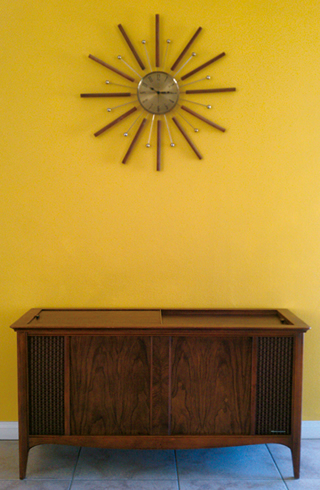How to Be a Minimalist in Real Life
 |
|
|
It’s spring cleaning time! Are you daunted yet? This is that time of year when tradition dictates you start culling all that wonderful “stuff” that steadily encroaches on your beautiful mid-century modern home all year. After all, minimalism is the baseline aesthetic for a lot of these places. Digging out from under our stuff is a hard job, and one we’re all inclined to put off. But there are ways of making minimalism work in the real world. Or at the very least, to manage our accumulated tchotchkes.
An insightful blog post by Pam Kueber on Retro Renovation points out the inherent conflict between the minimalist aesthetic of mid-century modern design and the people who actually live in those homes. It’s a bit ironic: If you’re into retro, you probably collect stuff, and that doesn’t work for minimalism. Even MCM design legend Vladimir Kagan said that while his designs are smooth and simple, his own home is crammed with tchotchkes. Kueber asked her readers to sound off on the duality, and they did, 111 times.
You, dear reader, do not have time to read all those comments. But if you did, you would find hidden in them a few concrete, employable strategies people use to keep clutter to a minimum. So to save you time, we’ve compiled the 10 best of those ideas in the list below, quoting from the original readers' comments. Once you're through here, we urge you to take a look at the original discussion on Retro Renovation.
- When I’m tempted to buy a new 1950s-1960s knick-knack, I ask myself what it is going to replace and how it will fit in with my overall decor. –Mary Elizabeth
- We had to impose a volume-in/volume-out rule when my daughter (a collector from birth) was growing up. The item in/out rule was too literally interpreted. Of course now that she is grown and we have an ‘extra’ room, the rule no long applies and we are the collectors! -Karen
- I’m lucky enough to live in a small town where, if I truly do regret giving up a vintage piece, I can usually find it again in a consignment, thrift, etc. shop. Yes, I have been known to buy an item back. (Can’t believe I just admitted that.) –Annie B.
- I grew up in a minimalist house. It was a small simple ranch house, built in the early ’50s. The interior design was done in the ’50s, 60′s and 70′s. It was in magazines. I think the secret to successful minimalist is not so much have a richness of ‘stuff’, but rather, a richness of texture. The colors were vibrant, the fabrics rich – not overwrought or baroque, but interesting, multi-dimensional in color and texture. The walls and carpets and floors were often colorful and/or interesting. I have inherited much of the furniture (as much as I could fit into a NYC apartment) and continue the tradition of richness. And minimalism. It works. And is an oasis in the chaotic city in which I’ve always lived. -Ruth
- The solution is not to sell all your stuff. The solution is to realize that you don’t have to display every piece at the same time, forever. Rotate! Create a tchotchke storage bin, and put out a twelfth of your collection each month. You’ll appreciate them more because you’ll have to actually interact with them, because they’ll have more room to be focal points, because you’ll miss them temporarily, and because they’ll stop fading into the background clutter. -Brian T
- After both my parents and my husband’s parents died (at very old ages), I realized the sad truth about ‘things.’ When we cleaned out their homes after they died, I’d say 90 percent went in a dumpster or to the Goodwill; which is what made me decide to purge my house of knick-knacks, etc. I’d ask myself… ‘Will my kids toss this in a dumpster after I die, and do I love it so much I don’t care?’ Three full pickup loads to the Goodwill later and I can say my house has never looked better, and I don’t miss a thing I donated that I know someone else will love. -Trudi
- I have met some of my crazy hoarding needs by having the various rooms in my house function, differently. Some are crammed full while others are a bit more sparse. I like the different feelings they evoke and depending on my mood, I definitely gravitate to one or the other. –Bunny Hudson
- On a practical level, it’s very hard to hold out for exactly what you want, especially when collecting items that are scarce. You may want an authentic Eames lounge, but in the meantime you need furniture and will probably cave and buy something mid-mod inspired from Ikea. I’ve done it myself a billion times. Function precedes form, especially when you’re in your twenties. -Sarah
- One of the things that I keep in mind when purging my ‘stuff’ is whether it’s replaceable. If it is, most of the time, I will go-ahead and get rid of it. If I decide down the line that I really need it, I can re-buy it. 99% of the time, I’m not missing anything I’ve gotten rid of! -Erin
- One thing that works for me is to realize that each piece usually looks best without much around it. I do have an office with walls and shelves chockfull of work so that satisfies that part of me. Also, and this would be for someone looking to move into a new place, i have a wall of windows in the living room, so I can’t hang anything there and it helps keep the piece peace. -Patrick
- ‹ previous
- 335 of 677
- next ›




